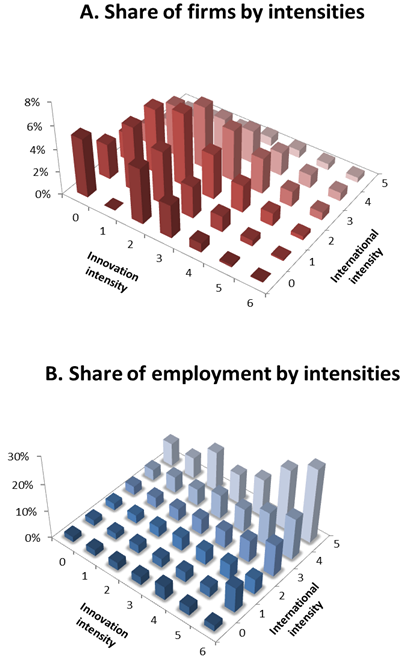Internationalisation and innovation of firms
The analysis suggests that policymakers should coordinate, if not integrate, innovation and internationalisation policies in order to boost productivi
This analysis was published by VoxEU on the 21 January 2014.
Internationalisation and innovation policies are frequently considered to be key drivers of growth. This column documents a strong positive association between internationalisation, innovation, and productivity at the firm-level across seven European countries. This association continues to hold after controlling for country, size, industrial sector, and firm specific characteristics, with some evidence of causality running from innovation to internationalisation. The analysis suggests that policymakers should coordinate, if not integrate, innovation and internationalisation policies in order to boost productivity and growth.
Policymakers traditionally have attempted to encourage internationalisation based on the implicit rationale that the latter is associated with productivity and/or employment growth. At the same time, since innovation is the key driver of productivity growth, much attention has been devoted to the specific channels through which trade and innovation are linked (see Aiginger 2011). However, in most European countries, as well as at the EU level, these policies are carried out through various, often unrelated agencies – as found by EIM (2010), a European report reviewing some 130 programmes. For instance, in Germany, it is BaFa, a federal agency that is responsible for export promotion while the Ministry of Economic Affairs deals with innovation. In France, responsibilities are also shared between two ministries and agencies such as BpiFrance. In Italy, ICE – an agency – does export promotion under the Development Ministry while R&D is under a number of different other governing bodies (Development, Economy, Education & Research ministry). In Hungary, NIH – the innovation agency – provides R&D grants while trade and investment promotion is done by HITA, another agency; additional sources are given via EU structural grants by yet other agencies.
In a recent paper (Altomonte et al. 2013) we exploit new data on European manufacturing firms to show that there is a positive and strong correlation between the extent of involvement of firms on both international and innovation activities. In particular, firms that export their goods and/or have set up factories abroad are, on average, also more likely to have invested into in-house research, introduced new IT solutions, or adopted new management practices. At the same time, firms that have no international exposure are the ones that typically have not innovated recently.
Broad measures of activities
To uncover these relations, we rely on the recently released EU-EFIGE/Bruegel-UniCredit (henceforth, EFIGE) dataset. This survey dataset covers a representative and cross-country comparable sample of manufacturing firms (with at least 10 employees) across seven European countries (Austria, France, Germany, Hungary, Italy, Spain, and the UK).
We find that in European manufacturing a large fraction of firms – 77% – are engaged in at least one mode of internationalisation (exporter, importer, outsourcer, outsourcee, FDI maker). At the same time, consistent with the idea of a self-selection of the most efficient firms driven by the costs of internationalisation (see the recent survey of Melitz and Redding 2012), being active in an increasing number of modes turns out to be more and more difficult – only 15% of firms are involved in all or all but one international activities. In turn, these firms are 3.5 times larger in terms of employment than internationally inactive firms, and they are almost twice as productive.
Can we spot a similar pattern regarding innovation? First, let us define broad innovation as consisting of seven modes: patents, copyright or design activity, internal R&D activity, external R&D activity, IT solutions for internal organisation, IT for sales, and IT for supply chain management. We decide to include IT activities in line with the evidence brought by Bloom et al. (2012) on the role of IT as a crucial catalyst of innovation. When using the broad measure of innovation, only 13% of firms are classified as inactive, while 7.5% are active in more than 5 modes. So, self-selection seems to be relatively less binding when a broad measure of innovation is taken into account, although the most innovative (based on our measure) firms are still four times as large as non-innovative ones, and they are 50% more productive.
Internationalisation and innovation: Inextricably linked
The interesting question is then to what extent internationalisation and innovation are jointly determined within a firm. Several existing studies point to various channels of interaction between internationalisation and innovation.
- First, the literature finds that innovation (in general measured only as R&D expenditures) and exporting – both endogenous choices requiring sizeable investments – are inextricably linked, although their sequence is a priori unclear. While Aw et al. (2011) find that the marginal benefit of both exporting and innovating simultaneously increases with productivity, with self-selection driving a large part of the complementarity, there is some evidence that product and (to a lesser extent) process innovation might drive exports at firm level (Cassiman and Golovko 2011).
- Second, it is also found that imports are related to innovation: almost all innovating firms import, and more innovative firms source more foreign products (Bøler, Moxnes and Ulltveit-Moe 2012).
- Third, when a larger amount of knowledge is embedded in the product, FDI becomes a more likely choice for foreign sales. Empirically, this evidence typically leads to a strong correlation among the extent of internationalisation and innovation activities.
Our sample confirms these findings, although it allows to nuance the latter correlation in a number of ways, as it allows to look at a broader definition of internationalisation (not only export) and innovation (not only R&D), then matched with additional firm-level characteristics observed across countries. In particular, we construct a measure of internationalisation intensity, defined as the number of internationalisation modes in which a firm is simultaneously involved, and innovation intensity, defined as the number of innovation modes in which a firm is simultaneously involved.
To that extent, the following figures show the distribution of firms and their shares of employment across innovation and internationalisation intensities. Panel A exhibits a pyramidal structure: innovation and internationalisation intensities are indeed positively correlated, but the share of firms involved in both high internationalisation and innovation intensity rapidly diminishes. Panel B reveals a similar pyramidal structure, offering evidence that higher intensities are also associated with better firm performance, as measured by firms’ size (employment). Hence, innovation and internationalisation, even when generally defined, seem to be inextricably intertwined with each other, and with firm success.
Figure 1. Distributions of firms across innovation and internationalisation intensities.

Source: Authors’ elaboration of EFIGE and AMADEUS data.
Furthermore, our analysis allows us to verify that the latter association continues to hold even after controlling for country, size, industrial sector, and firm specific characteristics, including total factor productivity, a variable that often is correlated with the same internationalisation and innovation as it is a proxy of a firm’s competitiveness. Finally, our analysis also hints at a direction of causality in the relationship between innovation and internationalisation, with the former seemingly driving the latter. Given the evidence of a harder selection in terms of internationalisation versus innovation activities, and in line with other findings of the literature (e.g. Bustos 2011), our data are consistent with the idea that firms might exploit innovation in order to ‘dress-up’ for some forms of international presence.
Bring them under one roof
The broad, robust, and strong correlation between firms’ internationalisation and innovation activities that we have uncovered in our analysis, as well as the possible direction of causality linking one to the other, suggests that trade promotion and innovation policies should be better coordinated to alleviate the current paradox of generally uncorrelated policies aimed at mostly correlated outcomes.
Consider the case of the European Union. Innovation policy is the responsibility of DG Enterprise and Industry. Trade facilitation is the responsibility of DG Trade. Export/import promotion is the responsibility of individual member states with little involvement of EU institutions. The mandate of DG Trade for export/import promotion is rather unclear.
Coordinating and integrating internationalisation and innovation policies under a single responsibility would likely be beneficial. It would make the relevant policymakers internalise the external effects of individual policies. On the one hand, uncoordinated actions could be ineffective and wasteful and result in ‘double subsidisation’ (30% of firms in our sample received some form of subsidy). On the other hand, they could forgo the gains arising from complementarities between various modes of innovation and internationalisation. In the presence of such complementarities, neither type of intervention would be very effective on its own. For instance, export promotion alone, without adequate investment in innovation, would not help firms develop the capabilities needed to successfully compete on international markets in the long run.
All in all, according to our analysis, positioning internationalisation and innovation policies ‘under one roof’ at both the national and EU levels, would be welcome.
References
Aiginger, Karl (2011), “The inefficiency of industrial and innovation policy in France”, VoxEU.org, 3 October.
Altomonte, C., Aquilante, T., Gábor Békés and Ottaviano G.I.P. (2013). “Internationalization and Innovation of Firms: Evidence and Policy”, Economic Policy, Volume 28, Issue 76, pages 663–700, October 2013.
Aw, Bee Yan, Roberts, Mark J. and Xu, Daniel Yi (2011). “R&D Investment, Exporting, and Productivity Dynamics,” The American Economic Review, American Economic Association, vol. 101(4), pages 1312-44, June.
Bloom, N., R. Sadun and J. Van Reenen (2012). “Americans do it better: US multinationals and the productivity miracle”, The American Economic Review, 102(1), 167–201.
Bøler, E. A., A. Moxnes and K. H. Ulltveit-Moe (2012). “Technological change, trade in intermediates and the joint impact on productivity”, CEPR Discussion Paper 8884.
Bustos, Paula (2011), “Trade Liberalization, Exports, and Technology Upgrading: Evidence on the Impact of MERCOSUR on Argentinian Firms,” The American Economic Review, American Economic Association, vol. 101(1), pages 304-40, February.
Cassiman, B and E Golovko (2011). “Innovation and internationalization through exports”, Journal of International Business Studies, 42(1), 56–75.
EIM Business & Policy Research (2010), “Internationalisation of European SMEs. Final Report”, Zoetermeer.
Melitz, M and S Redding (2012) “Heterogeneous Firms and Trade", NBER Working Paper No 18652, Washington D.C.


